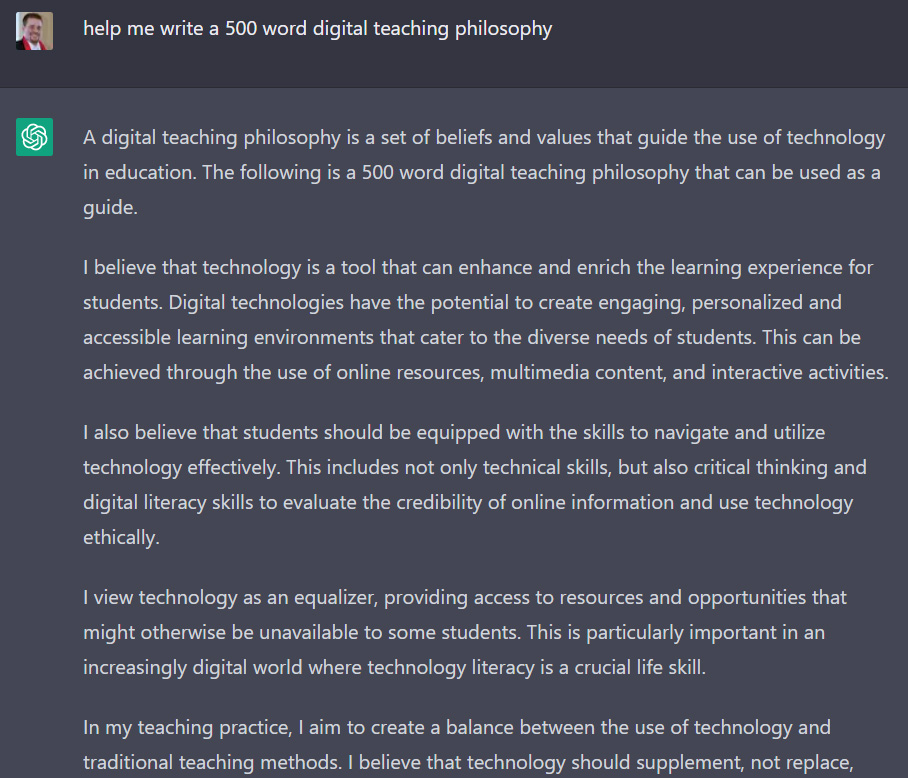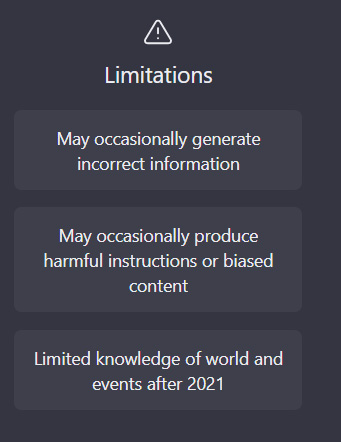Jake Martar, Ed.S
This article may be out of date. Please refer to the new 2.1.6 Artificial Intelligence Generative Tool Use Policy on the Academic Affairs Policy page for the latest guidance on using Generative AI tools.
https://academicaffairs.uams.edu/academic-affairs-policies/
Ever since the public launch of ChatGPT academic circles have been alarmed by its potential for abuse.
Let’s talk about some strategies for mitigating its’ use in class.
But first, what is ChatGPT?
ChatGPT is a chatbot powered by Artificial Intelligence (AI) to respond in human-like conversational tones. Simple inquiries through ChatGPT can produce remarkable replies. See the following example where I ask ChatGPT to help me write a digital teaching philosophy.

Why is Academia concerned?
As you saw from the example inquiry, the responses from ChatGPT can appear accurate and well-planned. This makes some fearful that the cheating possibilities will disrupt certain assignment types.
To add to the fear, currently, anti-plagiarism tools such as SafeAssign & Turnitin are unable to detect the use of ChatGPT and other AI generated responses.

Anti-plagiarism vendors have announced that they plan to develop measures to detect ChatGPT generated content, but it is important to note that AI is always changing and getting better. Also, ChatGPT is only one of several upcoming AI bots that may appear.
So what can you do?
Despite the potential for cheating, there are things instructors can do.
- Encourage your students to cite their sources.
Be sure to have your students cite sources in APA format. ChatGPT is currently unable to do this accurately. Citing sources will make it harder to use ChatGPT alone to complete an assignment. - Encourage discussions or activities around recent events.
Currently, ChatGPT pulls from data before 2021. While ChatGPT may update this data, it is unlikely to reflect knowledge of current events. ChatGPT is based on a pull of historical data. Therefore, try asking your students to reflect on or address current events that may not be recognized by ChatGPT’s databases. - Look for inaccuracies and educate your students.
Responses by ChatGPT are not 100% accurate. It is even possible to trick ChatGPT to report false information. In some cases, ChatGPT may even produce harmful content or recommendations. Be sure to educate your students on the ethical implications of AI and advise that you will spot inaccurate information. - Use ChatGPT as a teachable moment.
AI tools are not leaving anytime soon. Consider using ChatGPT as a teachable moment and explain the dangers. Explore the ethical consequences of using ChatGPT and its’ limitations. At some point students may use these tools in their respective professions. Help them navigate what is appropriate and what is not.

Where is AI going?
ChatGPT is just one example of the potential of AI to disrupt the way we conduct class. It is important to know that AI will only get better as time passes and more capabilities will appear. It is difficult to say what the next AI disruption will be.
However, it’s clear to me that AI isn’t going away. Much like a calculator, it is here to stay and we may need to shift our strategies on how to best use, rather than avoid these tools. Students need to understand how to best utilize AI tools in their professional settings.
Conclusion
That’s my thoughts and tips for beating ChatGPT in your class assignments. It will be interesting to see how AI evolves and how it will impact the classroom in the future.
Do you have additional tips for beating ChatGPT? More questions about ChatGPT? Do you know of other AI tools that are disrupting or helping the classroom? We want to hear from you. Contact us at BlackboardHelp@uams.edu.
Resources & Suggested Readings
ChatGPT and Education – Northern Illinois University
AI Bot ChatGPT Passes US Medical Licenses Exams... – Medscape
Deconstructing ChatGPT on the Future of Continuing Education – Inside Higher Ed
Making sense of AI & ChatGPT in education – edtechteacher
Educators Battle Plagiarism as … – Forbes
Two professors say they caught students cheating… – Business Insider
